Related Research Articles

The Angora or Ankara is a Turkish breed of domesticated goat. It produces the lustrous fibre known as mohair. It is widespread in many countries of the world. Many breeds derive from it, among them the Indian Mohair, the Soviet Mohair, the Angora-Don of the Russian Federation and the Pygora in the United States.

Vietnamese Pot-bellied is the exonym for the Lon I or I pig, an endangered traditional Vietnamese breed of small domestic pig.
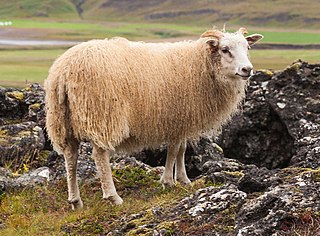
The Icelandic is the Icelandic breed of domestic sheep. It belongs to the Northern European Short-tailed group of sheep, and is larger than most breeds in that group. It is thought that it was introduced to Iceland by Vikings in the late ninth or early tenth century.
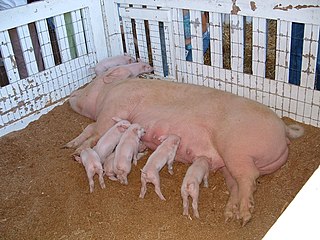
The American Yorkshire is an American breed of large domestic pig. It is the most numerous pig breed in the United States. It derives from pigs of the British Large White or Yorkshire breed imported from the United Kingdom or from Canada at various times from about 1830 to the mid-twentieth century.

The Yonaguni or Yonaguni uma (与那国馬) is a critically-endangered Japanese breed of small horse. It is native to Yonaguni Island, in the Yaeyama Islands in south-western Japan, close to Taiwan. It is one of eight horse breeds native to Japan.

The Devon is a traditional British breed of beef cattle. It originated in, and is named for, the county of Devon in the West Country of England. It is a deep rich red in colour, and so may be known as the Devon Ruby or Red Ruby; it may also be called the North Devon to distinguish it from the South Devon.

The Aegidienberger is a modern German breed of riding horse. It is named for the borough of Aegidienberg in the Rheinland, where it was bred in the latter part of the twentieth century. It is a cross of two foreign breeds, the Peruvian Paso and the Icelandic. Like the Icelandic horse, it can perform the tölt, a fast ambling gait.
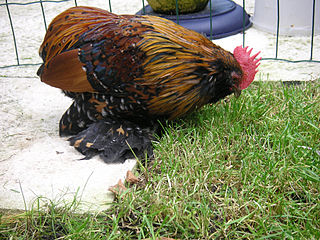
The Barbu d'Everberg, is a Belgian breed of bantam chicken. It is a tailless variant of the Barbu d'Uccle, and was bred in about 1906 at the Château d'Everberg, at Everberg in the municipality of Kortenberg, between Brussels and Leuven. It is among the most endangered chicken breeds in Belgium, and in 2010 its conservation status was classed as "critical". It is a true bantam, with no large counterpart. Cocks weigh 700–800 grams, and hens 550–650 g.
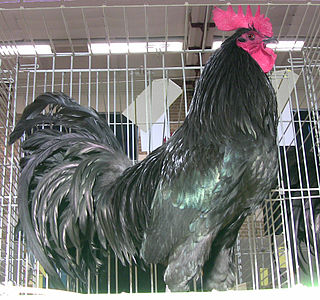
The Tomaru (唐丸) is a Japanese breed of long-crowing chicken. The crow may be sustained for some 25 seconds. It is one of four Japanese long-crowing breeds, the others being the Koeyoshi, the Kurokashiwa and the Tôtenkô.
The Blazer is a modern American breed of riding horse, bred particularly for ranch work. It was developed by Neil Hinck of Star, Idaho, from a single foundation stallion named Little Blaze. He bred for intelligence, strength, gentleness, easy gaits and overall suitability for work on a ranch. A breed association, the American Blazer Horse Association, was established in 2006. The Blazer is not listed in the Global Databank for Animal Genetic Resources of the FAO, nor is it reported to DAD-IS.

The Devon Longwool was a British breed of domestic sheep from south-west England. It was distributed in southern Somerset and northern Devon, and was – like the Greyface Dartmoor and the South Devon – a polled longwool sheep. It is now considered extinct, as in 1977 it was merged with the South Devon to form the Devon and Cornwall Longwool.
The British Spotted Pony is a British breed of pony characterised by a spotted coat. The height at the withers does not exceed 147 cm.

The State of the World's Animal Genetic Resources for Food and Agriculture is a major report on the genetic resources of breeds of farm livestock in the world. It was published by the Food and Agriculture Organization of the United Nations (FAO) in 2007. It covers mammalian and avian domestic livestock breeds, but does not include fish or honey bees and other invertebrates. It is based on information submitted to the FAO, in the form of reports of participating countries, thematic studies prepared by experts and data on individual breeds submitted to DAD-IS. An annex to the report, the List of breeds documented in the Global Databank for Animal Genetic Resources, gives an estimate of conservation status for all breeds for which sufficient data had been received. The report has been translated into Arabic, Chinese, French, Indonesian, Russian and Spanish.

The Swedish Red-and-White, Swedish: Svensk Röd och Vit Boskap, frequently abbreviated to SRB, is a Swedish breed of dairy cattle. It was created in the 1920s by crossing the Swedish Red Pied and Swedish Ayrshire breeds.
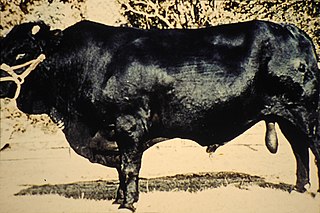
The Drakensberger is a South African breed of cattle. It is a dual-purpose breed, reared both for milk and for meat. Its origins go back to the early nineteenth century, to the time of the Great Trek or earlier, when imported European stock from Holland with was cross-bred with black cattle of Sanga type obtained from nomadic pastoralist Khoikhoi peoples. It is one of several successful African composite breeds of Sanga and European stock. In the early days it was selected for adaptation to the sourveld biome of South Africa, and for black colour; it was kept principally along the Drakensberg escarpment, which gave rise to its modern name. It was established as a breed with the formation of the Drakensberger Cattle Breeders' Society in 1947.

The Red Brangus is an American breed of hybrid beef cattle, with both taurine and indicine genetic heritage. Development began in Texas in the 1940s. It is a colour variant of the Brangus, a hybrid of American Angus and Brahman cattle, and differs from it only in colour. There are two herd-books, one international and one American. For international registration the animal must be of 5/8 Angus and 3/8 Brahman descent; in the United States, it may be any mix of the two breeds, but registration is conditional on inspection.

The Australian Merino is an Australian breed or group of breeds of sheep, forming a significant part of the Merino group of breeds. Its origins lie in Merino sheep imported to Australia from South Africa in about 1796. By about 1830 there were almost two million Merinos in the country.
References
- 1 2 3 4 5 Barbara Rischkowsky, Dafydd Pilling (editors) (2007). List of breeds documented in the Global Databank for Animal Genetic Resources, annex to The State of the World's Animal Genetic Resources for Food and Agriculture. Rome: Commission on Genetic Resources for Food and Agriculture, Food and Agriculture Organization of the United Nations. ISBN 9789251057629. Archived 23 June 2020.
- 1 2 3 4 5 6 7 Breed data sheet: Iceland. Domestic Animal Diversity Information System of the Food and Agriculture Organization of the United Nations. Accessed June 2021.
- 1 2 3 4 5 6 Valerie Porter, Lawrence Alderson, Stephen J.G. Hall, D. Phillip Sponenberg (2016). Mason's World Encyclopedia of Livestock Breeds and Breeding (sixth edition). Wallingford: CABI. ISBN 9781780647944.